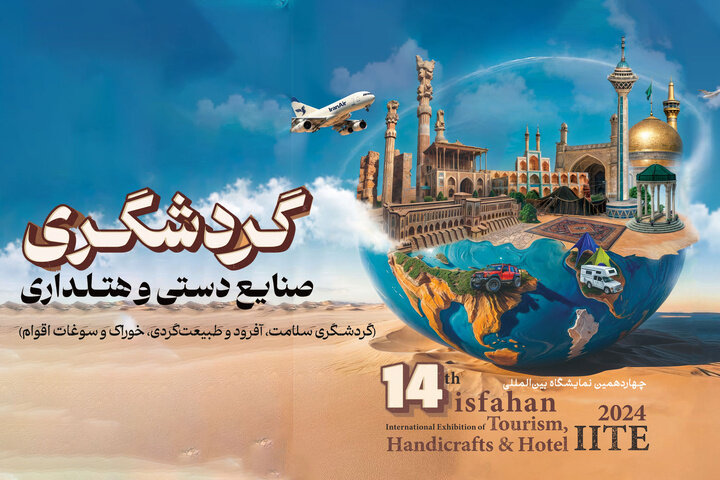International tourism, handicrafts exhibition to be held in Isfahan

TEHRAN- The 14th edition of the International Exhibition of Tourism, Handicrafts and Hotel plans to be held in the central Iranian province of Isfahan, the provincial tourism chief has said.
The exhibition will open its doors to the public on Thursday and will be running until December 1 at the permanent exhibition venue in Isfahan, featuring active participants from both domestic and international tourism sectors as well as artisans from across the country, Amir Karamzadeh explained on Wednesday.
He also elaborated that the exhibition will cover an area of 6,500 square meters, and will be organized in collaboration with five tourism organizations from Isfahan, including the Society of Travel Agencies, the Association of Tour Guides, the Hotelier Community, the Traditional Restaurants Association, and the Isfahan Handicrafts Union.
He added that, through diplomatic efforts, representatives from Pakistan, Malaysia, Armenia, the Republic of Tatarstan in Russia, Kuwait, and Russia’s St. Petersburg will participate in the event.
He emphasized that delegations from Pakistan, Iraq, Turkmenistan, Malaysia, Algeria, and Russia are expected to visit the exhibition as well.
Karamzadeh also highlighted that, in cooperation with the Isfahan municipality, delegations from Isfahan’s sister cities, including St. Petersburg, Yerevan, Kazan, Kuwait, and Kuala Lumpur, will also attend the exhibition.
Earlier this month, Karamzadeh announced that Isfahan province exported over $15 million worth of handicrafts during the past Iranian year (ended on March 20).
Amir Karamzadeh said the figure doubles that of a year earlier. He attributed the substantial growth in exports to the province’s recovery efforts following the COVID-19 pandemic and expressed optimism about future prospects.
“While exceeding $15 million in exports is a significant achievement, we believe this figure does not fully reflect Isfahan’s true potential. Through strategic planning, we aim to further boost this number in 2024,” he added.
Karamzadeh made the remarks during the 37th National Handicrafts Exhibition, highlighting Isfahan’s remarkable progress in the sector.
“We are honored to present over 20 handicraft categories at this exhibition, showcasing the work of skilled artisans, many of whom hold national and global certifications,” he said.
Isfahan continues to strengthen its position as a leading exporter of handcrafted goods, contributing to Iran’s cultural and economic growth, the official said.
A city of historical significance
The ancient city of Isfahan, situated at the crossroads of Iran’s north-south and east-west trade routes, reached its zenith between the 9th and 18th centuries. During the Safavid era, it became Iran’s capital under Shah Abbas the Great. Renowned for its Persian-Islamic architecture, the city is home to historical landmarks such as Naqsh-e Jahan Square, a UNESCO World Heritage site.
Once a bustling crossroads of international trade and diplomacy in Iran, Isfahan has evolved into one of the country’s premier tourist destinations, drawing visitors from far and wide. Renowned for its wealth of architectural marvels, including unparalleled Islamic edifices, bustling bazaars, enriching museums, picturesque Persian gardens, and charming tree-lined boulevards, Isfahan offers a tapestry of experiences for the discerning traveler.
Situated along the banks of the Zayandeh-Rood, Isfahan, the provincial capital, boasts not only a plethora of historic bridges but also owes much of its allure to the life-giving river, which has endowed the city with an innate beauty and fertility. Dubbed Nesf-e-Jahan, or “Half the World,” Isfahan’s grandeur in its prime rivaled that of cities twice its size, boasting a population nearing one million.
The iconic blue tiles adorning Isfahan’s Islamic structures and its stately bridges stand in stark contrast to the arid expanse of the surrounding Iranian countryside.
At the heart of the city lies the expansive Imam Square, also known as Naghsh-e Jahan Square, spanning an impressive 500 meters by 160 meters. Dating back to the early 17th century, this UNESCO-recognized square is adorned with Isfahan’s most captivating landmarks, offering a glimpse into the city’s rich history and architectural splendor.
Beyond its cultural treasures, the city has emerged as a leading hub for medical tourism, boasting a cutting-edge healthcare complex that attracts patients from around the globe, solidifying its status as a premier destination in the realm of medical tourism.
SAB/
Leave a Comment